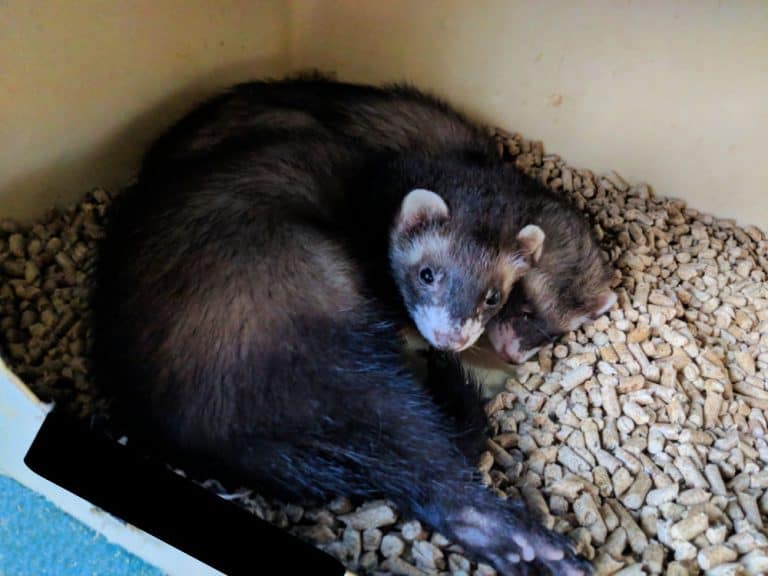Everything You Need to Know About Waardenburg Syndrome in Ferrets
If you own a ferret, you’ll know that they are fun-loving, boisterous animals who can be very sassy. But did you know that they can also suffer from a condition called Waardenburg syndrome, which can cause them to be deaf? This condition is relatively common in ferrets, especially in pets that have white markings.
Ferrets make great pets as they are loving and entertaining. If you have a pet ferret, you’ll also know that they can be very stubborn. Your ferret may not want to listen to you, especially if they are up to no good. This behavior could be due to selective deafness, but if you feel that your ferret never listens to you or you worry that it may be deaf, it could have a genetic condition called Waardenburg syndrome. The condition is common in ferrets and other small mammals, humans can even have the syndrome.
What is Waardenburg Syndrome in Ferrets?
Waardenburg Syndrome is a type of genetic condition, also known as a neural crest disorder. Waardenburg Syndrome, named after a Dutch ophthalmologist called Petrus Johannes Waardenburg, is a genetic defect that runs on a spectrum of severity. And it is often correlated with high amounts of white markings, though you can have a “Waardy” without white markings and a ferret with white markings that is not a Waardy.
This article will explain everything you need to know about Waardenburg syndrome, which is also called Neural Crest disorder in ferrets. We’ll discuss how to tell if your ferret is affected by the condition and look at common symptoms and ways that you can test your ferret to see if it’s deaf.
What is a “Waardy” ferret?
A “Waardy” ferret is born with the genetic condition, Waardenburg Syndrome, which causes minor defects in the neural crest pathways of affected ferrets. The condition is associated with specific colors and color patterns that include lots of white markings. The main characteristic with this condition is deafness. Roughly three-quarters of ferrets that have both the color and color pattern markings common with the condition will be deaf.
Waardenburg syndrome symptoms include deafness; this may be partial deafness, or your pet could be totally deaf. It also causes changes to the pigmentation of the eyes, fur, and skin. Many animals that have Waardenburg syndrome have one brown and one blue eye. Their skin and fur will have lighter patches.
Are Ferrets the Only Animals Affected by Waardenburg Syndrome?
No, ferrets are not the only animals affected by Waardenburg Syndrome. The condition is relatively common in ferrets and other small mammals that are kept as pets. The condition can also affect larger animals, such as cats and dogs, and even people. However, don’t worry if your ferret has Waardenburg syndrome; you can’t catch it from them. Waardenburg syndrome is a genetic condition that is passed down to a ferret from its parents. You would need to be born with the condition.
Waardenburg syndrome can vary in its severity from very mild, with not many symptoms to severe. In more severe cases, there will be problems such as deafness, cranial defects, and a broader skull with eyes that are wider set.
Ferret, with the condition, may look like they have a baby face and could suffer from gastrointestinal problems. In ferrets, the condition causes cognitive deficits, behavioral issues, and a lack of knowledge about acceptable social skills. Some ferrets also have an abnormal gait, which is due to bone problems. They also tend to be more prone to health problems and even have a shorter lifespan.

How to tell if your ferret has Waardenburg syndrome?
In ferrets, Waardenburg syndrome causes defects in the crest pathways and is related to certain color patterns of the fur. The condition is more common in animals that have the color patterns and white markings associated with the syndrome. The disease is also commonly characterized by deafness, but this doesn’t necessarily mean that your ferret is deaf in both ears.
If your ferret has the color patterns that accompany Waardenburg syndrome, they are likely to also be deaf, as three-quarters of ferrets with these white markings are deaf. Your ferret is most likely to have the condition if it has a small white stripe, which is often called a blaze on the back of its head. Ferrets that are entirely white or have a totally white head, from the end of the nose to the back of the head, are likely to be affected. This type of marking is known as a panda pattern.
Ferrets that have Waardenburg syndrome also have eyes that are further apart than other ferrets. Their head may also have a slightly flattened appearance, due to the shape of the skull.
If you think that your ferret may have Waardenburg syndrome, you can check to see if it’s deaf. If you’re unsure whether your ferret has the condition, you should check with a vet who can confirm whether your suspicions are correct.
Vets believe that there’s a connection between ferrets who have Waardenburg syndrome and other diseases too. Many ferrets with the condition are predisposed to have Juvenile Lymphosarcoma. This affects their liver, kidney, lungs, and spleen and requires treatment; otherwise, it could result in organ failure and even death.
How does Waardenburg syndrome develop in ferrets?
Waardenburg syndrome is also called neural crest disorder in ferrets as a problem in the neural crest cells causes it. These cells don’t develop properly when the ferret is still in its mother’s womb. Neural crest cells start to grow in the embryonic stage and become mutated. They migrate throughout the embryo to become other organs or cartilage, nerves, and tissues.
When neural crest cells have this disorder, the ferret can develop several conditions, including albinism or melanoma. These conditions both affect the pigment of the fur, skin, and eyes. Problems with the crest cells also mean that the ferret’s nervous system isn’t as fully developed as it should be. This can lead to other health problems, including problems with the digestive system, and sometimes the ferret’s bones can be affected.
How to Tell if your Ferret is Deaf
Sometimes you can tell if your ferret is deaf by observing its behavior. It may not follow the typical ferret social rules. Observe your ferrets carefully to see how they play together, and this will give you a clue as to whether or not your ferret has the condition. This is an excellent thing to do if your pet has a flatter head shape and typical markings and fur patterns. The following behavior is likely to indicate that your ferret is deaf and has Waardenburg syndrome.
Many ferrets that have Waardenburg syndrome are mute or have almost speechless vocalizations. Like any other animal, if a ferret can’t hear, it wouldn’t have learned which sounds to make and is likely to keep quiet. Other ferrets with the condition will be extremely loud, as they can’t hear themselves and don’t realize how much noise they are making.
A deaf ferret may not be able to pick up on normal ferret social ques. For example, when playing with other ferrets, it may seem more aggressive or rough than acceptable. When play fighting, a deaf ferret won’t stop or respond when the other ferret squeals. This would usually be a cue to stop but will be ignored by a deaf ferret who has Waardenburg as it hasn’t heard the auditory feedback from their playmate.
You may also notice that your ferret makes odd head movements if it’s hard of hearing or deaf. A ferret with Waardenburg syndrome may crane its head backward or hold its head in a tilted position to one side.
How can I test my ferrets hearing?
Not all ferrets that have Waardenburg syndrome are totally deaf. Some ferrets with the condition, it only affects their skin pigment, and their hearing is normal. Others will be partially deaf.
If your ferret has fur markings associated with Waardenburg and you want to see if it’s deaf or not, there are several tests that you can carry out at home. There will be many visible signs of deafness that you should look out for, the most prominent being not responding to loud noises. A deaf ferret will react to movement and vibration, but won’t respond to sound.
Startles Easily
As well as checking if your ferret responds to very loud noises, you should also see if they can hear quieter sounds. Check if your ferret is startled when you creep up on them unawares? Although this is not a totally accurate test as your ferret could recognize your presence by feeling vibrations through the floor. You can also try making noise, such as clapping your hands loudly to see if your ferret jumps or looks towards the sound source.
Compare Behavior with Other Ferrets
If you own multiple ferrets, you could also observe your ferrets as a group and compare the reactions of the one you suspect to being deaf with others’ reactions. Does one ferret fail to respond to your voice, while the other ferrets catch on?
Vacuum Test
Another great tip that you can use to test if your ferrets deaf or not is to put in on the floor and then turn on your vacuum cleaner. Most hearing ferrets will be scared and run away, whereas a deaf ferret won’t be bothered at all.
How to care for a ferret with Waardenburg syndrome
There are some disadvantages to ferrets living with Waardenburg syndrome; however, most will be relatively healthy and live normal lives. The main problem of Waardenburg Syndrome is dealing with a hearing-impaired animal, and your ferret will need special care if they have the condition. Waardenburg syndrome would be more of a disadvantage to ferrets living in the wild as their survival would rely on them being aware of predators.
Pet ferrets that live in the home are protected from predators and will generally live a happy life. Some may suffer from health problems, especially intestinal issues. If you are worried about your ferret’s health, speak to your vet who can recommend a special diet if necessary.
Try not to startle your ferret as your ferret may bite you if he gets a fright. You should avoid creeping up on a deaf ferret, and should instead approach him from the front. Don’t try to pick up a ferret who doesn’t know that you’re there and make sure that visitors to your home know that your ferret is deaf so that they don’t startle him.
How to train a deaf ferret?
There may be some slight adjustments that you’ll need to make if you own a deaf ferret. You’ll need to change how you communicate with your pet and train your ferret to respond to different commands.
Most people communicate verbally with their ferrets, but when you have a deaf pet, you’ll need to find other ways to make yourself understood. Ferrets are smart animals and are usually fast learners; deaf ferrets can pick up other cues from their owners.
Your ferret will still be able to read your facial expressions and can feel vibrations and respond to visual cues. Instead of saying “no” to your ferret, you can make a hand gesture or shake your head. You may even like to make a frowning or angry face. If the same action is repeated, again and again, your ferret will soon learn what you mean.
Instead of calling your ferret’s name, you can tap the floor to tell them that you are approaching. When you knock or tap the floor with your feet, this will send your pet vibrations and get their attention. You can also use your room lights to get a ferret’s attention by flicking the light on and off.
Are there any treatments available for Waardenburg syndrome?
There aren’t currently any treatments or cures available for Waardenburg syndrome. The symptom which is likely to cause you and your pet the most problems is deafness, so you’ll need to find effective ways to communicate with your ferret. Ferrets with other symptoms or abnormalities such as bone or neurological issues may need treatment symptomatically.
Many people who have a deaf ferret continue to talk to their pet as if it could hear. They say that a ferret can pick up on their owner’s emotions, and talking to your pet may seem normal, even if he can’t hear you.
Caring for your other pets
If you own more than one ferret and one of them has Waardenburg syndrome, your other pet may need extra care. You should carefully observe how well your pets get on, and if they are fighting too much, they may need to be separated.
As mentioned above, deaf ferrets are unable to tell when the other ferret has had enough, and play fights may last longer than they otherwise would. Make sure that your ferret has space to get away from each other if they need to.
You may need to keep your ferrets in separate enclosures while you are not at home. You can allow them to play together while supervised; this will enable you to separate any fights. In many cases, deaf ferrets will be able to live with hearing ferrets as they usually would, and there won’t be a problem.
Why is Waardenburg syndrome becoming more common?
Waardenburg syndrome is a genetically inherited condition that means that one or both of the parents pass it down to their offspring. The condition has become more prevalent over the years due to selective breeding for popular color and pattern traits.
When ferrets were first domesticated and bred, they were used for hunting. These animals are great for flushing rabbits from their burrows. White ferrets were more popular as they could be easily spotted amongst the grass and thickets. Selected breeding caused more ferrets to be born with albinism, a genetic condition similar to Waardenburg. In general, the whiter a ferret is, the less “wild” it looks. Humans are often drawn to animals with white fur, especially if they have white hair on their faces. Animals that have white face markings and boots, socks or mitts are often considered cute as they seem less wild.
Nowadays, most breeders wouldn’t breed from a ferret with Waardenburg syndrome as it can be passed on to the offspring. Waardenburg syndrome can be severe, and some ferrets will die of the disease while they are still young. Responsible breeders should breed ferrets carefully to help eliminate the condition.
Conclusion
Responsible pet owners who have a ferret with Waardenburg syndrome should learn about the condition as much as possible. Being well informed about this condition will allow them to help their ferrets and limit their suffering. If you think your ferret has Waardenburg, you should take it to a vet who can check for deafness and make sure that it doesn’t have any characteristic symptoms, such as stomach problems or bone issues. There is no treatment for Waardenburg syndrome, but ferrets with the condition are prone to other treatable health problems. A vet will be able to access your ferret and recommend any treatment.
Waardenburg syndrome is a genetic condition which is known as neural crest disorder in ferrets. It varies in severity, and in mild cases, the ferret will live a relatively healthy life. Ferrets that have more severe cases can have deformities, intestinal problems, and deafness.
There are many ways that you can communicate with your ferret if they are deaf, and this doesn’t have to hurt their quality of life. A deaf ferret can still feel vibrations and will respond to visual cues. Many ferret owners use a laser light to train their ferret, hand signals, or they replace the click in clicker training with a treat. Ferrets are generally smart animals who will respond to their owner’s commands.








